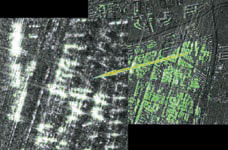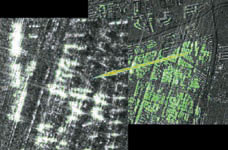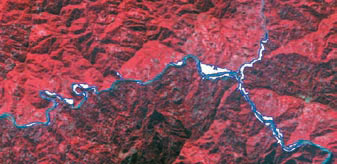| Mycoordinates | |
Role of Photogrammetry and Remote Sensing in Wenchuan Earthquake
|
Deren Li
|
||||
|
An earthquake, measured 8.0 on the Richter scale, struck Wenchuan County, Sichuan Province at 14:28 on May 12, 2008. The epicenter was at Yingxiu, a town in Wenchuan, as shown in Figure 1. As indicated in Figure 1, the middle segment of the Longmen Mountain earthquake zone encloses the epicenter, Yingxiu, with the Longmen Mountain zone Figure 1. The Wenchuan earthquake in context In Wenchuan earthquake, the worst hit areas include Beichuan and Qingchuan, with the earthquake intensity measured at 11, with the maximum being 12 by the Chinese seismic survey standards. By 12:00 pm on June 14, 2008, the death toll read 69,170, with 374,159 people injured, 17,428 people missing,and a population of 48,270,000 severely affected by this huge disaster. Figure 2 shows the beauty of Beichuan before the earthquake against the destruction and devastation after the earthquake. Figure 2. Pictures showing Beichuan before and after the earthquake. Figure 3. Aerial photography flown with ADS40 (GSD: 0.3 m) showing what was left of Yingxiu Town in Wenchuan after the earthquake on May 15, 2008. Figure 4. The image acquired by Cosmo (at a resolution of 1 m) indicating the locations (white segments) where buildings are likely collapsed after the earthquake; up to 14.8% of the areas were suspected to be results of collapsed buildings. Figure 5. The change of river water ways due to the forming of quake lakes in Tangjiashan, as indicated by white regions generated by comparing SPOT5 (10 m resolution) images taken before (November 10, 2006) and after (May 16, 2008) the earthquake. Figure 6. The DEM of the quake lake in Tangjiashan, Mianyang city, Sichuan Province, one of the area worst affected by Wenchuan earthquake, which was generated based on ALS50 II air-borne LiDAR data with a sampling interval of 2 m, flight date, May 31, 2008, by the State Bureau of Surveying and Mapping, Wuhan University, and Wuda Geo Information Company (the barrier dam is shown with a inset picture) |
||||
Pages: 1 2

















 (No Ratings Yet)
(No Ratings Yet)





